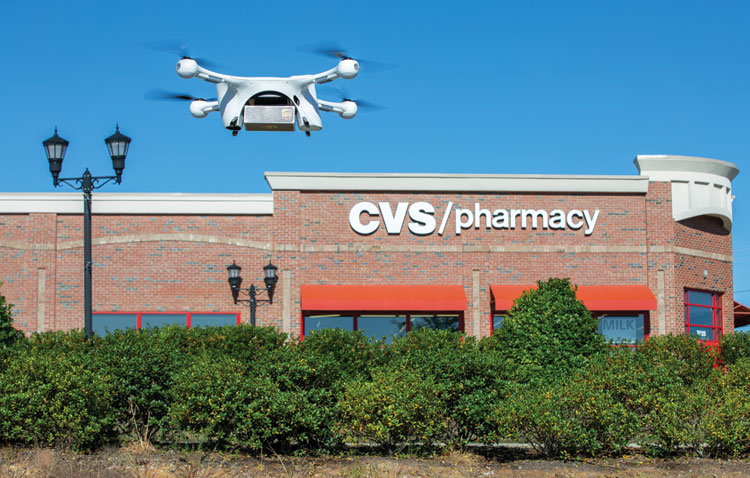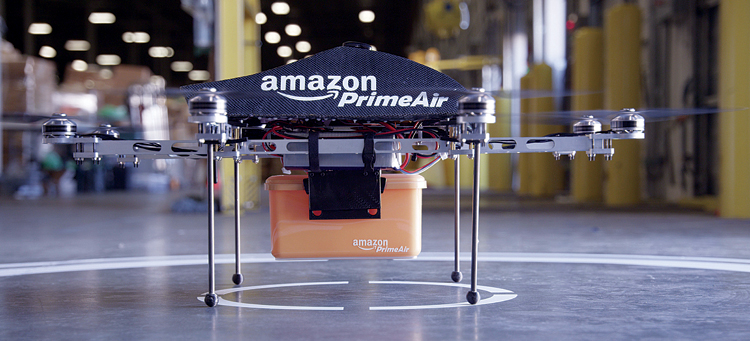Drones as the Future of Transport
With the advent of drones, things are set to become better and improve the quality of lives of millions of impatient people who inhabit the earth

Today, as the population is growing and the number of vehicles on the roads is increasing, it is causing a considerable chaos almost everywhere on the earth. The highways are blocked, roads are congested and there is encroachment on the roads. Everybody wants to reach their destination and get their deliveries at the earliest. This is a difficult expectation. However, with the advent of drones, things are set to become better and improve the quality of lives of millions of impatient people who inhabit the earth.
A drone is a small device which flies along a pre-determined route through a system of propellers. The most important thing is that a drone is unmanned. It can be controlled manually with the use of special remote equipment. Alternatively, it can be pre-fed with the coordinates of points that it will traverse to travel between places.
The drones today, apart from being programmable to follow a particular itinerary, are capable of returning to the launch point thanks to algorithms such as Simultaneous Localisation and Mapping (SLAM). Drones come in various sizes. As a result, different payloads can be fitted on them as per the requirements. Electronic devices, sensors, electro-mechanical devices and many such combinations of functional add-ons can help the human society to be integrated with a drone.
EMPLOYABILITY OF DRONES
The uniqueness of the drones is their ability to take off and land vertically anywhere. They are programmable to carry out multifarious tasks. China has started using drones that detect people moving without wearing a face mask. A drone then comes near the person and announces loudly to them to put on their face masks. This is used to contain the spread of corona virus on a real time basis. Moreover, drones can also be utilised to deliver medicines, food, clothing and other supplies to the quarantined victims of corona virus. This protects the paramedics from the virus and at the same time, the requisite resources reach the target population.
Disaster management is the next most important realm where drones can be used. Drones, when fitted with suitably gridded cameras, can detect the population density over disasterprone areas such as large gatherings at human congregations. As a result, whenever the density of humans per square metre rises above the limit, it can automatically detect and trigger an alarm to the control station. Disaster management forces can then move in and control the situation.

Once disaster has already struck in a particular place, sensors can be mounted on drones which could then transmit back live images where the dead or the injured may be lying. The requisite disaster management forces can then be directed to prevent further damage and loss of human life. Of late, agriculture has seen a vivid adaptation of drones. Farmers have fixed electro-mechanical devices on drones that dispense seeds, manure, urea granules, insecticide and pesticide sprays to have a uniform spread over designated areas. This reduces the cost of cropping. The farmer in return, saves money and is also not exposed to hazardous chemicals. Today, farmers face the problem of stray cattle destroying their crops. Consequently, drones can be used during day and night to detect ingress of cattle into the farmlands and also use suitably mounted speakers on the drones to scare the cattle away. This is a harmless way of protecting crops from damage by cattle.
Amazon is the first to use drones to deliver merchandise to customers. All that needs to be done is that suitable clamps need to be fixed onto the drones that can lift the tote bags containing various deliverables. The drone can then be flown to the delivery point and the pre-loaded face recognition software can help in detecting the right customer in order to unlock the tote bag restraining contraption. This way, emergency supplies, hot food, chilled drinks and even laundry can be delivered to the consumer quickly by avoiding all road-based bottlenecks.
Another advantage is that the delivery staff has to operate within human waking hours whereas drones can deliver at anytime, to any suitable technically approved area. It does not depend upon the waking life cycle of human beings. It is free from any tolls, police barricades and traffic jams as in the case of surface transport.
Drones can also monitor wildlife. They can pick up the bio samples floating on the surface of the ocean, rivers or within the core areas of the jungle. A drone can track elephants that tend to enter into human settlements resulting in human - elephant conflict. If suitable numbers of drones are employed, then the movement of elephant herds can be tracked and using high endurance loud sound emanating drones, the animals can be channelised back into the forest areas.
On finding animal carcass within the jungle, drones can be used to fly down and pick up flesh samples for DNA checking. Endangered animals like the whales can be studied as considerable evidence of their DNA, stress levels and pregnancy-based hormones can be found from an analysis of secretions at its blow holes. Highly manoeuverable drones can be used to extract exudes from the blow holes of the whales as they come to the surface to breathe.
Drones are indeed the future of air transport; their use is limited to the human imagination
Drones can be mounted with metal detectors, thermal detectors, avalanche victim detectors and ion-based sensors that can detect environmental pollutants, humans and metals on the surface of the Earth or slightly below it. Calibrated drones, can map archaeological sites during e excavation. The bird’s eye view of the excavation indicates the magnitude and the anthropological lifestyles which the generations enjoyed at the archeological site.
Since a medical emergency can take place anywhere, a small hospital may not be equipped to have all the requisite analysis tools, implants and sophisticated medical equipment. In such a case, a drone can simply move the requisite material from the central repository to the site where the emergency surgery is required to be carried out. Thus, precious human lives can be saved as also the cost of stocking of implants and tools at different places can also be minimised.
Medical implants can be stocked and delivered through a huband-spoke model with drones. The critical and expensive medical equipment and implants can be stored at a pre-designated hub. Whenever the need arises, the requisite items can be delivered by a drone along the spokes. This minimises the cost of holding of inventory and reduces the chance of medicines and implants overshooting their shelf life.
Power lines near the pylon touch points usually accumulate carbon. This raises the resistance. Heavy-lift capacity drones with water supply, water propulsion mechanisms and with onboard camera fly up to the wire and squirt water to wash away the carbon deposits on the insulators ruling out the danger of electrocution of humans. Drones can be used to carry out cable inspection of overhead high voltage lines above railway tracks especially near traction joints. A drone will beam back live images of the wires. This will not disrupt the railway traffic and at the same time, provide a visual clue about the health of the copper cable.

Usually, the fractional distillation towers of refineries have to be periodically inspected for cracks, leakages, corrosion or metallurgy failure. Once, the distillation process is going on, it is difficult for technicians to climb the tower. This issue can be mitigated by using drones to beam back live images to the control station. This will give an indication of the health of the refinery. Refineries produce toxic sulphur compounds while distilling crude oil. If a person works for long periods in a refinery, he loses his olfactory sense to detect sulphur fumes. Consequently, if a worker ventures out carelessly into the sulphur predominant areas, there is a chance that he will lose consciousness. In order to save human lives, drones fitted with sulphur-detecting sensors, can be flown through pre-planned itineraries and detect the levels of sulphur compounds permeating out of the distillation infrastructure.
The uniqueness of the drones is their ability to take off and land vertically anywhere
Such equipment can also be used for checking the health of the boilers, chimneys of factories. Outdoor transformers too can be inspected this way. So, human beings that way are not exposed to the dangers of electrocution or burning as the case may be.
Drones can be programmed to return to their point of launch in case of low battery. This is a great safety and asset safeguarding capability. Logisticians while moving merchandise by drones do not need to plan for tolls, delays at police barriers or in traffic jams. Usually, one human per vehicle is required to operate it. However, in the case of drone logistics, one man can control the flight itineraries of multiple drones and deliveries at the same time by staggering their timings. So, the cost of operations of a drone vis-a-vis that of a vehicle is considerably lower.
The success of drone-based logistics lies in the integration of computer vision-based face recognition system, artificial intelligence, machine learning and big data analysis in order to optimise cost and maximise profit. The use of mathematical tools will indicate the minimum investment required to procure drones and operate them for a given workload.
Drones are indeed the future of air transport; their use is limited to the human imagination. As better mechanical equipment becomes available that is able to programme itself to minimise its downtime and maximise its work time, it will make life easier for the human beings and reduce cost of logistics considerably.





